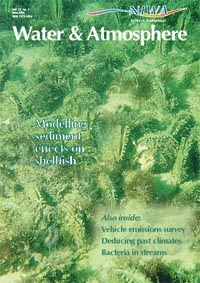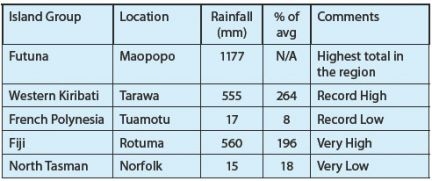PDF of this article (610 KB)

Jelena Ajtić Brian Connor
Modelling studies have confirmed that the Antarctic ozone hole is a major player in the lower summer ozone levels measured over New Zealand.
Every spring NIWA scientists inform the public about the current status of the Antarctic ozone hole – how big it is, how much ozone has been depleted, whether it is likely to break early or late in the season, and if yet another record in its properties has just been set. However, the public is never told about the thing that matters the most: how much less ozone (and UV protection) can we expect in the summer that follows?
Of course, the question is not an easy one to answer. Unlike the ozone hole itself, which has been extensively studied over the past twenty years, the hole’s influence on the ozone levels in mid-latitudes has been tackled only sporadically. On the other hand, we do know that in southern mid-latitudes annual total ozone is approximately 6% lower than in the 1970s. Furthermore, measurements of total ozone conducted at the NIWA site at Lauder, Central Otago, show that the negative ozone trends are greater in summer than in any other season. Are these negative ozone trends correlated with the Antarctic ozone hole?
In late 1998, we detected an unusual decrease in ozone over Lauder at an altitude of about 24 km. This atypical vertical profile of ozone prompted further questions: What was the origin of that ozone-poor air? Was this an example of how Antarctic air influences ozone levels in New Zealand? Brian Connor from NIWA and Bryan Lawrence (then with the University of Canterbury) decided it was time to delve deeper into the problem and saw it as a good project for a PhD. Jelena Ajtić took the opportunity and, after four years of research, we are now able to offer some answers.
Transient and long-lasting influence of the ozone hole


Each year, the ozone hole forms in early spring in a tightly contained stratospheric vortex created by intense cooling in winter over Antarctica. As spring progresses and the stratosphere warms, the vortex becomes unstable and finally breaks apart. A modelling study, tracking air parcels in this process, unveiled the origin of the ozone-poor air we had identified over Lauder: it was transported from Antarctica to New Zealand as the vortex broke up.
As first suggested, this event is a good example of a transient reduction in ozone over New Zealand due to the presence of Antarctic air. The effect lasted only for a few days because the air masses containing ozone-poor air moved away from New Zealand.
However, those ozone-poor air masses moved on to another region, where they again reduced ozone levels. So, instead of concentrating only on localised and severe examples of the influence of the Antarctic ozone hole, we extended the modelling study to quantify the impact on the southern mid-latitudes as a whole. We concentrated on late spring and early summer in the years 1998, 1999 and 2000.
The results showed that ozone reduction in the region encompassing New Zealand and Australia progressively increased from October to January. In October, the impact of the Antarctic ozone hole was most pronounced in South America and South Africa. This is because the ozone hole often protrudes into those mid-latitude regions before breaking up.
By late spring, the ozone hole was less well defined than it was earlier in the season, and began to spread more readily into mid-latitudes, leading to an increase in ozone dilution. After the breakdown of the Antarctic ozone hole, which usually occurs in late November or early December, large parts of the hole were transported northwards where they mixed with the surrounding air (see figure). As a consequence, in late December and early January, when the total amount of ozone plays a crucial role in ultra-violet (UV) exposure at ground level, ozone reduction was the same everywhere in southern mid-latitudes.
What do the results tell us?
We can get a better understanding of the impact of the modelled ozone reductions if we compare the results with measured total ozone. Therefore, we combined the results from the modelling study with satellite measurements of total column ozone to infer how much less ozone there has been in recent summers in southern mid-latitudes due to the influence of the Antarctic ozone hole. The analysis showed that, on average, in mid-latitudes the ozone hole has resulted in 5–6% less ozone in spring and summer, which corresponds to 6–7% more erythemal UV – that is, the UV irradiation that causes sunburn. Furthermore, this suggests that dilution of the Antarctic ozone hole is a major contributor to the observed ozone reduction in southern mid-latitudes.
This study answers only some of the questions posed earlier. To get a more complete picture of the impact of the Antarctic ozone hole, more years should be analysed. In the meantime, our modelling technique could be used to yield a rough seasonal prediction of the summer ozone reduction in mid-latitudes before the ozone hole breaks down. After all, “Forewarned is forearmed”.
Teachers’ resource for NCEA AS: Science 3.2; Chemistry 3.1. See other curriculum connections at www.niwa.co.nz/pubs/wa/resources
Jelena Ajtić and Brian Connor are based at NIWA, Lauder.
